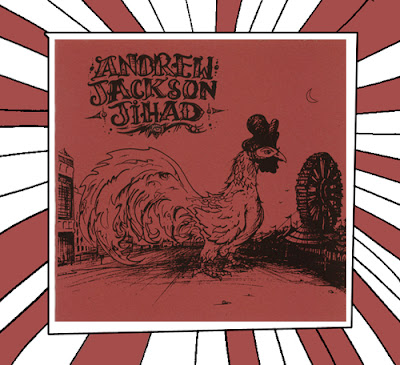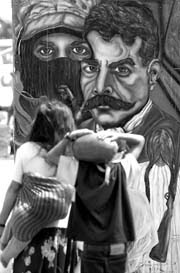Pod is on your music app! Search: TranceSendDance
Aug 4, 2007
Aug 2, 2007
Jihad

"According to the pair, the band's moniker comes from a fusion of the toughest mo-fo American president and a word for "struggle." Keen subject matter ranges from cutting a piece off baby Jesus to the stupidity of smoking, all fronted by a furious, lighthearted lead vocal wit that includes lyrics such as "Fuck white people/Kill the white devil" and "I like telling dirty jokes/And I like smoking crystal meth/But darling I love you." Bow down to the gritty and raw audio confusion."
About Andrew Jackson Jihad
"We have a drunkolin player named Dylan Westley Cook now. He has a beard but now it is short. He might shave lightning bolts into it. Swan Song Sean-Claude Danger Vincent Bonnette Danger exclusively plays seagull brand guitar. Benjamin Ora Gallaty does music with a large violin. We have been together for one year and Justin James White doen't play drums with us anymore. Andrew Lane plays trumpet sometimes. Jeff Mayfield aka Piltatope aka ghostface killah played saw once. Jalipaz did clapping and backups on our record. Jalipaz recorded us very hard. He is also the kingpin behind a group of friends called The audioconfusion Manifesto. Oh yeah, Mike Montoya played drums for us several times. and now Owen Richard Evans plays the banjo. He also plays fools like chumps at bonez. "
Art manifesto
From Wikipedia, the free encyclopedia
The Art manifesto has been a recurrent feature associated with the avant-garde in Modernism. Art manifestos are mostly extreme in their rhetoric and intended for shock value to achieve a revolutionary effect. They often address wider issues, such as the political system. Typical themes are the need for revolution, freedom (of expression) and the implied or overtly stated superiority of the writers over the status quo. The manifesto gives a means of expressing, publicising and recording ideas for the artist or art group— even if only one or two people write the words, it is mostly still attributed to the group name.
Manifestos were introduced with the Futurists in Italy in 1909, and readily taken up by the Vorticists, Dadaists and the Surrealists after them: the period up to World War II created what are still the best known manifestos. Although they never stopped being issued, other media such as the growth of broadcasting tended to sideline such declarations. Due to the internet there has been a resurgence of the form, and many new manifestos are now appearing to a potential worldwide audience. The Stuckists have made particular use of this to start a worldwide movement of affiliated groups.
Manifestos typically consist of a number of statements, which are numbered or in bullet points and which do not necessarily follow logically from one to the next. Tristan Tzara’s explanation of the manifesto (Feeble Love & Bitter Love, II) captures the spirit of many:
| “ | A manifesto is a communication made to the whole world, whose only pretension is to the discovery of an instant cure for political, astronomical, artistic, parliamentary, agronomical and literary syphilis. It may be pleasant, and good-natured, it's always right, it's strong, vigorous and logical. Apropos of logic, I consider myself very likeable. | ” |
We are apart of The audioconfusion Manifesto along with:
a feast unknown
an aesthetic
andrew jackson jihad
art vandalay
asleep in the sea
blankets
hack bandit
peachcake
swordfish
the orphan line
tremulants
check out our sister collective: ZOMBIES AND PIRATES
Introduction
The manifesto was previously a political document of state. Indeed the declaration of war in 1914 was embodied in a document titled a “manifesto”. This background is extremely informative when assessing the positioning and impact of the manifesto as adopted by the early artistic users of it, who were subverting, even destroying, the form, as part of an overall challenge to art and society.Although it might be assumed that an art manifesto's primary purpose is to communicate the aesthetics of the group issuing it, this turns out not to be the case, nor is it an art form in its own right. The norm is a hybrid form that combines a theatrical performance with political declamation. [1] Artists have not restricted themselves to their own genre, although they have often used their skills in the presentation of the text through graphics and type faces, resulting in a combination of "art, publicity, criticism, and advertising".[2]
Martin Puchner stresses the inescapable connection between the art manifesto and the political manifesto, not least because artists also issued overt political statements and allied themselves with political groups. Marinetti tried to gain a political office and both Italian and Russian Futurists issued political manifestos. Lenin was espoused by the Zurich Dadaists, and Rosa Luxemburg by those in Berlin. In England the Suffragettes were supported by Vorticist Wyndham Lewis, and the Communists by Surrealist Andre Breton in France. However, the attentions of the artists were often not welcomed. Marinetti found himself stymied by Italian dictator Benito Mussolini, and Velimir Khlebnikov by Leon Trotsky, while Breton was an outcast from the French Communist party and Guy Debord resorted to starting an independent group. [3]
I Am For An Art... Manifesto, 1961
by Claes OldenburgClaes Oldenburg, a Pop artist, reacting against Abstract Expressionism, along with other young artists. The Manifesto ‘I am for an Art’ was originally made to be included in the catalogue of the 'Environments, Situations and Spaces’ exhibition. Each of the statements begin with 'I am for an art...'.
Here is a quote from the first two statement in his poetical manifesto,
"I am for an art that is political-erotical-mystical, that does something other than sit on its ass in a museum.
I am for an art that grows up not knowing it is art at all, an art given the chance of having a staring point of zero... "
( Harrison, C. and Wood, P. (2006) Art in Theory, 1900-2000: an Anthology of Changing Ideas. 2 ed. USA: Blackwell Publishing)
Claes Oldenburg info and art at Artsy
Punk and cyber 1976–1998
The rise of the punk movement with its basic and aggressive DIY attitude had a significant input into art manifestos, and this is reflected even in the titles. Some of the artists overtly identified with punk through music, publishing or poetry performance. There is also an equivalent "shocking" interpretation of feminism which contradicts the non-objectification advocated in the 1960s. Then the growing presence of the computer age began to assert itself in art proclamations as in society.Cheap Art Manifesto 1984
by the Bread and Puppet TheaterThe whole title is "the Why Cheap Art? manifesto". It is a single sheet, issued by the Bread and Puppet Theater "in direct response to the business of art and its growing appropriation by the corporate sector." There are seventeen statements, most of them beginning "Art is" and ending with an exclamation mark, set out mostly in upper case, sometimes mixed in with lower case, in different typefaces which get bolder through the leaflet till the final statement of a large HURRAH. It starts:
- People have been thinking too long that art is a privilege of the museums & the rich.
- Art is not business!
World wide web 1999–
Widespread access to the internet has created a new incentive for artists to publish manifestos, with the knowledge that there is an instant potential worldwide audience. The effect of the internet on art manifestos has been described: "One could almost say we are living through a new boom time for the manifesto. The Web allows almost anybody to nail a broadsheet to the virtual wall for all to see."[19] Some of the manifestos also appear in print form; others only exist as virtual text. It has also led to a great diversity of approaches, as well as a noticeable trend looking back at earlier traditions of Modernism or the Renaissance to create a present and future paradigm. The Stuckists manifesto has become well known, though most others have achieved little individual reputation or impact.Only one type of torture is not an atrocity
Consensual tickle torture.
Tickle torture most often involves restraining a person so they cannot pull or move away from the source of tickling, finding highly ticklish spots on the body, and then subjecting the victim to prolonged tickling over minutes or even hours.
As public humiliation, however, tickling would be an effective torture. In addition, a person being tickled and laughing cannot eat, drink, or sleep, meaning death by exhaustion if not by respiratory arrest, which is theoretically possible.
Another example of tickle torture was used in Ancient Rome, where a person’s feet are dipped in a salt solution, and a goat is brought in to lick the solution off. This type of tickle torture would only start as tickling, and in the end wind up being extremely painful.
The stocks are perhaps a device which gives credence to tickle torture as an actual torture method in that stocks are designed to restrain a person’s ankles, exposing their bare feet, thus allowing passersby to torture the soles with various methods such as tickling. According to tour guides at Colonial Williamsburg, people in the stocks could expect tormentors to “take off your shoes and socks and tickle your bare soles and toes.”
Another form of tickle torture is between siblings, lovers, and friends. In this scenario, one or more people gang up on one victim, proceed to hold down that person and tickle them to the point of helpless laughter. They will focus on tickling sensitive areas, like the soles of the bare feet and underarms. In this environment, however, the tickling perhaps last for no more than a few minutes and, should a person actually begin experiencing severe pain or discomfort the tickling would either be stopped by the initiators or another party (such as a parent) would step in.

Tickle torture
From Wikipedia, the free encyclopedia
Tickle torture is a form of torture where a victim is subjected to tickling over a prolonged period of time.Tickle torture most often involves restraining a person so they cannot pull or move away from the source of tickling, finding highly ticklish spots on the body, and then subjecting the victim to prolonged tickling over minutes or even hours.
Contents |
Is tickle torture real?
The debatable nature of tickle torture begins in that, historically, there is little evidence that it was actually practiced as a method of hard torture. Well-known torture epidemics, such as the Salem Witch Trials and the Spanish Inquisition, used methods of torture far more painful than acidosis from simple tickling.As public humiliation, however, tickling would be an effective torture. In addition, a person being tickled and laughing cannot eat, drink, or sleep, meaning death by exhaustion if not by respiratory arrest, which is theoretically possible.
Possible tickle torture forms
"Chinese tickle torture" is a term used in Western Society to imply an ancient form of torture practiced by the Chinese, in particular the courts of the Han Dynasty. Chinese tickle torture was allegedly a punishment for nobility since it left no marks and a victim could recover relatively easily and quickly.Another example of tickle torture was used in Ancient Rome, where a person’s feet are dipped in a salt solution, and a goat is brought in to lick the solution off. This type of tickle torture would only start as tickling, and in the end wind up being extremely painful.
The stocks are perhaps a device which gives credence to tickle torture as an actual torture method in that stocks are designed to restrain a person’s ankles, exposing their bare feet, thus allowing passersby to torture the soles with various methods such as tickling. According to tour guides at Colonial Williamsburg, people in the stocks could expect tormentors to “take off your shoes and socks and tickle your bare soles and toes.”
Another form of tickle torture is between siblings, lovers, and friends. In this scenario, one or more people gang up on one victim, proceed to hold down that person and tickle them to the point of helpless laughter. They will focus on tickling sensitive areas, like the soles of the bare feet and underarms. In this environment, however, the tickling perhaps last for no more than a few minutes and, should a person actually begin experiencing severe pain or discomfort the tickling would either be stopped by the initiators or another party (such as a parent) would step in.
Consensual tickle torture
In the world of fetishism, tickle torture may be found as an activity between two partners where one will tie up and tickle the other. Trends on Internet tickling websites and chat rooms also shows an increased level of recent interest in tickling partners in pantyhose. The pantyhose are used to increase a person’s ticklishness (especially on the feet) and may be worn by both men and women in this tickling experience.
Germans ~ Alemaniacos


So,
the Germans (Aryans) created the printing press. To make the written word more easily accessible to the masses.
the Aryans created cocaine also.
the Aryans created chemical warfare and agriculture as well.
the Aryans still think they are superior to everyone, even themselves.
the Aryans have complete control of the government and military of the U.S.A...
regardless of which faction calls the shots.
That is a rigged game,
this is the last gasp of a master about to be taught.
Gnosis (from the Greek word for knowledge, γνώσις) is used in English to specify the spiritual knowledge of a saint or enlightened human being. It is described as the direct experiential knowledge of the supernatural or divine. This is not enlightenment understood in its general sense of insight or learning (which in Greek is διαφωτισθούν)[1] but enlightenment that validated the existence of the supernatural. The Oxford English Dictionary defines it as, 'A knowledge of spiritual mysteries.' From the word gnosis is derived Gnostic and Gnosticism the latter a modern construct referring to one of various near eastern schools which claimed to have supernatural knowledge flourishing during the early Christian era. The term being Koine Greek has, nonetheless, a much broader application than being exclusive to any sectarian group. The term is used by Byzantine and Hellenic cultures as a word to mean a special knowledge or insight of the supernatural. In some sense mature understanding or knowledge. It is the knowledge that comes from experience rather than from rational or reasoned thinking as in intuitive knowledge (see gnosiology).
http://en.wikipedia.org/wiki/Gnosis
http://www.gnosticteachings.org/index.php?option=com_content&task=view&id=563&Itemid=10114&fontstyle=f-larger
"So, this Aryan Root Race, instead of evolving, has devolved, and its corruption is now worse than that of the Atlanteans in their epoch. Its wickedness is so great that it has reached unto heaven." - The Kabbalah of the Mayan Mysteries

Old People
Subscribe to:
Posts (Atom)
Beautiful Babylon Babies Unite !!!
This Blog existed after Bush II "the lesser" stole 2 elections, before Google ate Blogger,
Hits of the Month
-
Tonight i got some fantastic news from some people that help to make me who i am... the following blogs/websites/pages also inspire me ...
-
http://www.nytimes.com/2008/11/22/health/22radio.html?_r=1&hp Radio Host Has Drug Company Ties By GARDINER HARRIS Published: November...
-
http://www.soawne.org/ The same fascist U.S. Bush family led government that arrested me in 2004 for protesting the RNC has shut down the ma...
-
This global economic turmoil is a result of three zeros. There is a gap between the proofs of mathematics and the realities of a global ec...
-
Yesterday i finally saw Michael Moore's latest film. It is a brilliant, compelling nonpartisan exploration of how corporations have take...
-
"There has been more material progress in the United States in the 20th century than there was in the entire world in all the previous...
Poetic HyperLinks Defeating the Impossibilities of Peace
Also sprach Zarathustra to the brothasistahs lost out in the woods…
Rolling stones and hurricanes prime us for the rapid eye movement of whose dream?
A stairway to the dark side of the moon reveals an orchestrated King
singing the blues while sexual pistols whip Jesus’ son.
Who’s influence weens us?
Me and my friends gratefully raged against the machine for three days
in the shadow of the valley of the dead
so big brother and company held us down while the wind cried
nothing to be gained here (except copied rights),
Then a questing tribe of beastly boys found a digable plant
where a buffalo soldier picked up a Gideon’s bible from the Godfather
in joe’s garage (or was it in one of 200 motels?)
Anyway, on a Holiday, the pinball wizard boy (Billie)
followed his heart and stopped pretending he was the king of the little plastic castles
while education, missed in the house of the naked apes, evolved and mutated
into and with ~ Nature Art Love Truth ~ and we do too…
And somewhere over the rainbow dancing fools send clowns and purple rain
into imagine nations where everything is now sacred
and there are no more public enemies or rusted Roots or minor threats
or bad brains or busted rhymes or widespread panic
and everyone can read the hieroglyphics on the wall
and we are all refugees of courtney’s love attaining nirvana….
But then again, you’re so vain, you probly think this poem’s about you-
we are everywhere and we cannot be beaten
it’s all over now baby blue, all we need is Love
Legalize It
Rolling stones and hurricanes prime us for the rapid eye movement of whose dream?
A stairway to the dark side of the moon reveals an orchestrated King
singing the blues while sexual pistols whip Jesus’ son.
Who’s influence weens us?
Me and my friends gratefully raged against the machine for three days
in the shadow of the valley of the dead
so big brother and company held us down while the wind cried
nothing to be gained here (except copied rights),
Then a questing tribe of beastly boys found a digable plant
where a buffalo soldier picked up a Gideon’s bible from the Godfather
in joe’s garage (or was it in one of 200 motels?)
Anyway, on a Holiday, the pinball wizard boy (Billie)
followed his heart and stopped pretending he was the king of the little plastic castles
while education, missed in the house of the naked apes, evolved and mutated
into and with ~ Nature Art Love Truth ~ and we do too…
And somewhere over the rainbow dancing fools send clowns and purple rain
into imagine nations where everything is now sacred
and there are no more public enemies or rusted Roots or minor threats
or bad brains or busted rhymes or widespread panic
and everyone can read the hieroglyphics on the wall
and we are all refugees of courtney’s love attaining nirvana….
But then again, you’re so vain, you probly think this poem’s about you-
we are everywhere and we cannot be beaten
it’s all over now baby blue, all we need is Love
Legalize It

































